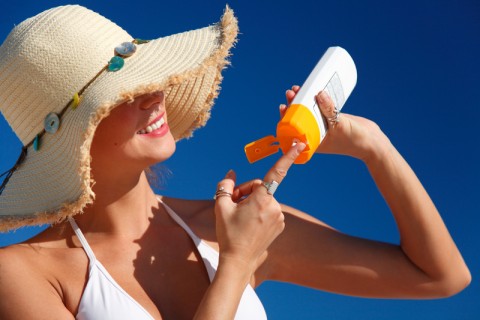Ever wonder about your sunscreen’s active ingredients and what they do? Some, like Mexoryl and Tinosorb S are buzz worthy and make headlines. But you shouldn’t be swayed by the media. To make the most well-informed decisions about sunscreen, it’s important to read labels and realize that not all sunscreens are created equal. With summer quickly approaching, now is a good time to review some basic information about UV rays and which active ingredients work to protect against them.
The UV rays that concern us can be divided into UVA (for Aging) and UVB (for Burning) rays. The SPF (Sun Protection Factor) ratings on sunscreens only reflect the protection they provide against UVB rays. UVB rays are rays of medium wave length and measure between 280 nm and 315 nm. To help determine the amount of SPF that you need, consider this:
If you burn within 10 minutes after being in the sun without any protection, then a product with an SPF of 10 will give you 10 times additional protection (100 minutes in the sun). An SPF 30 product will deliver 30 times additional protection in the sun (300 minutes) and so on. The key to adequate protection is to apply liberally and reapply often. This is especially true if you are swimming or perspiring. Applying a product with SPF 30 along with a product that has SPF 60 will NOT give you SPF 90 protection. Studies have shown that most of us do not apply an adequate amount of sunscreen nor do we reapply often enough.
UVA rays are longer and penetrate deeper into the skin than UVB rays. UVA rays can be further divided into UVA-I rays (340-400 nm) and UVA-II (320-340 nm). UVA rays are as strong at sunrise as they are at sunset and can even penetrate glass. They are prevalent every day of the year, rain or shine. UVA rays will Age your skin and are responsible for wrinkles, age spots and saggy, leathery skin as well as some forms of skin cancer.
As you wade through the myriad of sunscreens available on the market today, look for some of these key active ingredients to ensure the most comprehensive, broad spectrum protection for you and your family:
- Titanium Dioxide : blocks UVB rays
- Zinc Oxide : blocks both UVB and UVA rays measuring 300-400 nm. Zinc oxide is one of the few full UV spectrum sun blockers. Look for it if you are concerned about applying a chemical sunscreen. We like Keys Solar RX or Cliniderm SPF 45 Lotion
- Mexoryl SX: may also be listed as Terephthalylidene Dicamphor Sulfonic Acid; blocks UVA rays measuring 290-400 nm.
- Mexoryl XL: may also be listed as Drometrizole Trisiloxane; blocks UVA-II rays
- Avobenzone: blocks UVA-I rays; should be stabilized with Octocrylene
- Tinosorb S: blocks UVB and UVA rays measuring 280 nm to 400 nm
The important thing is to select a photostable, broad spectrum sunscreen with a combination of active ingredients that protects your skin from both UVA and UVB rays. Questions? Give us a call and we’d be happy to help you choose a sunscreen that’s right for you .




